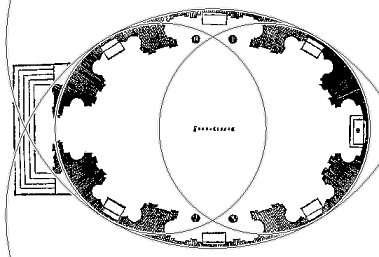
| On Serlio's Construction of Ovals |
|---|
Department of Computer Science, Cardiff University
Queen's Buildings, Newport Road, Cardiff CF24 3XF, UK
Due to a combination of aesthetic and religious reasons the classical and early Renaissance architects considered the circle to be the ideal form. Nevertheless, the ellipse is a pervasive shape that has occurred in architecture over the millennia (from ancient stone rings, through the Roman ampitheatres, to present day buildings such as Johnson and Burgee's "Lipstick Building"'). Not only that, but it occurs over a range of scales, from decorative details such as paterae, to the oval rooms popular in the Georgian architecture of mansions, to individual buildings, and finally combinations of houses such as Wood's Royal Crescent at Bath.
 Although the mathematics
of the ellipse was well understood, there are practical difficulties
in their construction. Mechanical drawing devices such as trammels
were used in the Renaissance, but could not be readily applied
to the large scale marking out of buildings. Alternatively, there
are techniques such as the well known "gardener's method"
in which two pins or pegs are placed at the foci and a length
of string is attached to the pegs. The pen is pulled out against
the pegs against the string and around, thereby drawing out the
ellipse. A problem with this approach is that factors such as
uneven tension of the ropeand variations in the angle of the
pen lead to inaccuracies.
Although the mathematics
of the ellipse was well understood, there are practical difficulties
in their construction. Mechanical drawing devices such as trammels
were used in the Renaissance, but could not be readily applied
to the large scale marking out of buildings. Alternatively, there
are techniques such as the well known "gardener's method"
in which two pins or pegs are placed at the foci and a length
of string is attached to the pegs. The pen is pulled out against
the pegs against the string and around, thereby drawing out the
ellipse. A problem with this approach is that factors such as
uneven tension of the ropeand variations in the angle of the
pen lead to inaccuracies.
An alternative approach was given in Sebastiano Serlio's celebrated Quinto Libri d'Architettura published over the period 1537-1575. Here, four techniques for the simple and reliable construction of ovals were introduced which have since been applied by many architects across Europe. Using various geometric forms (i.e. the triangle, square, and circle) as a basis they produced ovals made up from four circular arcs.
Serlio's constructions and some of the many possible alternatives
were analysed and their accuracy evaluated in terms of the ovals'
approximations to an ellipse. We found that Serlio's constructions
do reasonably well, but are certainly not the closest to the
ellipse (although of course this may not reflect their aesthetic
qualities). For instance, a construction by James Simpson (based
on a method by the famous mathematician James Stirling) does
uniformly well and is generally superior. In addition, Vignola's
construction does especially well. Nevertheless, some simple
extensions made by the author of Serlio's constructions mostly
perform poorly. This shows how apparently plausible constructions
do badly, and suggests that some care was taken in developing
Serlio's original constructions.
ABOUT
THE AUTHOR
Paul
Rosin is
senior lecturer at the Department of Computer Science, Cardiff
University. Previous posts include lecturer at the Department
of Information Systems and Computing, Brunel University London,
UK, research scientist at the Institute for Remote Sensing Applications,
Joint Research Centre, Ispra, Italy, and lecturer at Curtin University
of Technology, Perth, Australia. His research interests include
the representation, segmentation, and grouping of curves, knowledge-based
vision systems, early image representations, machine vision approaches
to remote sensing, and the analysis of shape in art and architecture.
He is the newsletter editor for the British Machine Vision Association.
|
Paul Rosin, "On Serlio's Construction of Ovals", abstract, Nexus Network Journal, vol. 2, no. 3 (July 2000), http://www.nexusjournal.com/conferences/N2000-Rosin.html |
|
|
|
|
